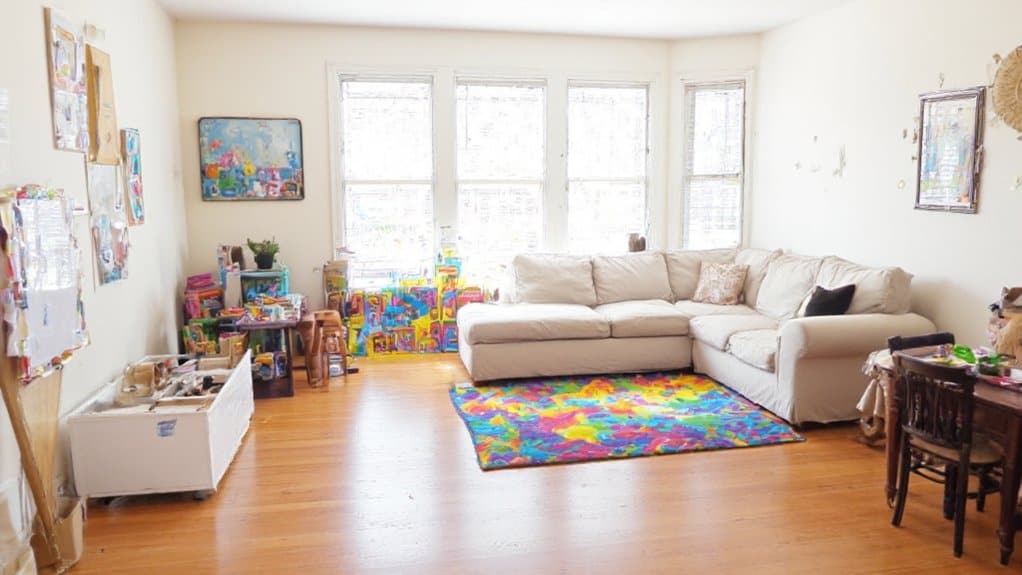Ever feel like Mary Poppins, trying to magically transform a messy space into a kid’s paradise? I’ve been there, and I’m thrilled to help you carve out a playroom in your living room! Let’s kick off with measuring a 10×10-foot area—grab that tape measure and mark it out.
Trust me, my first attempt was a comedy of errors with misplaced rugs! Curious how to avoid my blunders? Stick around!
Before You Start
Before you plunge into turning your living room into a playroom, let’s chat about a few things to ponder upfront. I’ve been there, and trust me, planning saves headaches! First, check your space.
Measure Twice, Laugh Once!
- Measure your living room—grab a tape measure and note at least 10×10 feet for play space.
- Watch out for furniture hazards; move sharp-edged tables away!
I once tripped over a coffee table mid-setup—ouch! Also, think about flooring. Is your carpet soft enough for tumbles? If not, consider padding. Let’s avoid DIY disasters together, okay? Plan smart!
What You Will Need
Hey there, let’s get rolling on setting up that playroom in your living room! Man, I’ve had my share of DIY flops, like when I bought the wrong shelf size—ugh! But don’t worry, I’ve got you covered with the essentials.
Here’s what you’ll need to grab:
- Storage Bins – Pick colorful ones, about 12×12 inches, to stash toys neatly.
- Kid-Friendly Rug – Get a soft, 5×7 foot rug to define the play space.
- Adjustable Shelves – Opt for a 3-tier unit, around 36 inches wide, for books and games.
Let’s make this awesome together!
Step-by-Step Guide
Hey, let’s get started on turning your living room into an awesome playroom with these key steps! I’m so excited to guide you through defining the play area, adding toy storage, incorporating safety measures, picking comfy seating, and creating playful decorations—oh boy, I’ve had a few funny DIY flops with decor myself! Stick with me, and we’ll make a space your kids will love!
1. Define Playroom Area
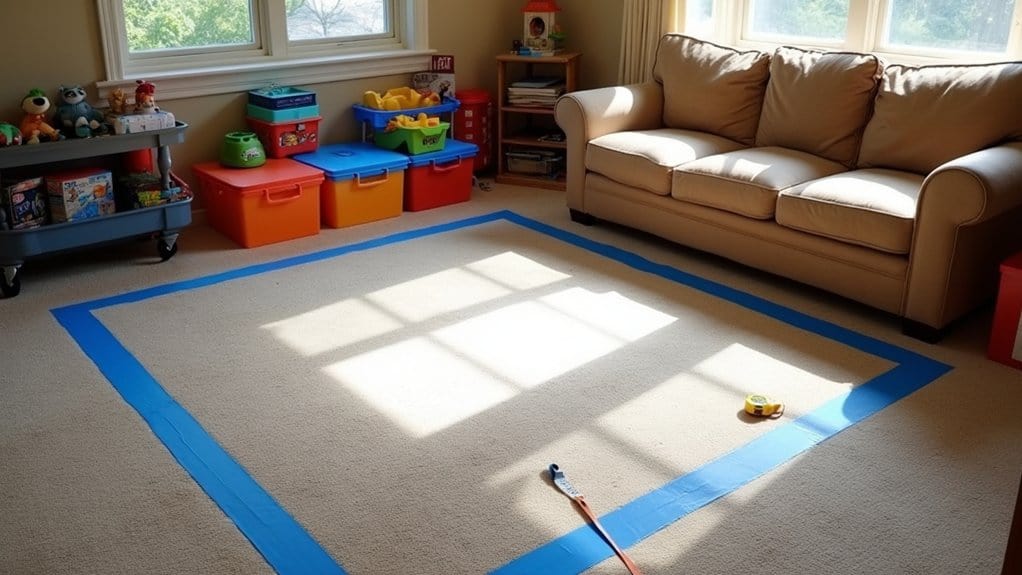
While setting up a playroom in the living room might sound like a puzzle, I’m excited to help you carve out the perfect spot for your little ones! Trust me, I’ve had my share of DIY flops—think crooked shelves—but we’ll nail this together!
Start by picking a corner or wall section, ideally 6×6 feet, for your play area. Measure it out with a tape measure! Use painter’s tape to mark boundaries on the floor. It’s cheap at about $5 a roll and won’t wreck your flooring. Wow, look at that—your play space is taking shape already!
2. Add Toy Storage
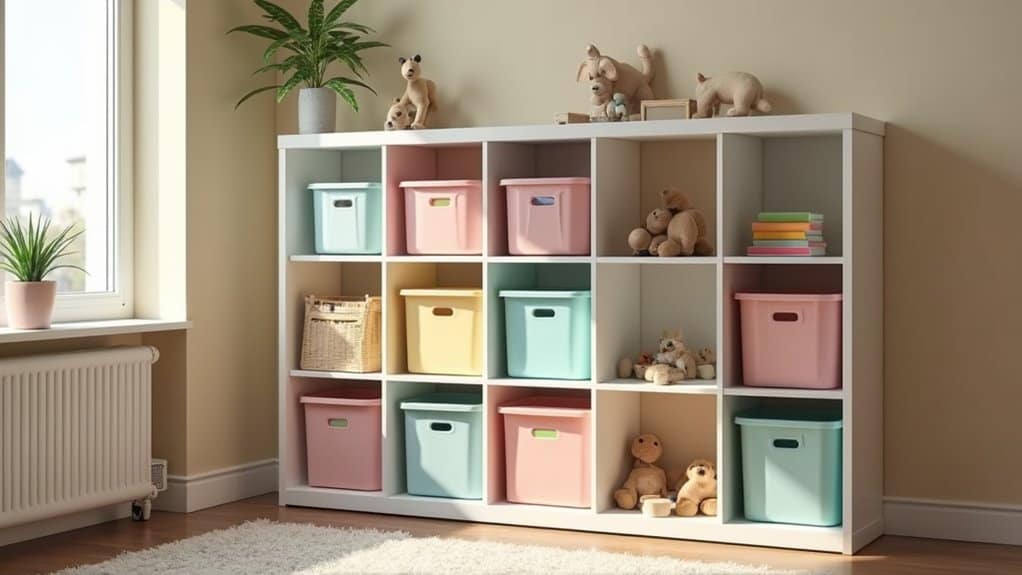
Got your play area marked out? Awesome, let’s tackle toy storage next! I’ve tripped over enough action figures to know chaos isn’t cute—yikes!
First, pick storage that fits. Grab stackable bins from Target, about 12”x12” each, or a low bookshelf (under 3 feet tall) from IKEA. They’re perfect for little hands!
Next, organize by type—cars in one bin, dolls in another. Label ‘em with cute stickers! Finally, secure heavier units to the wall with anchors; I once dodged a falling shelf—total DIY fail! Keep it tidy, and you’ve got a win for playtime!
3. Incorporate Safety Measures
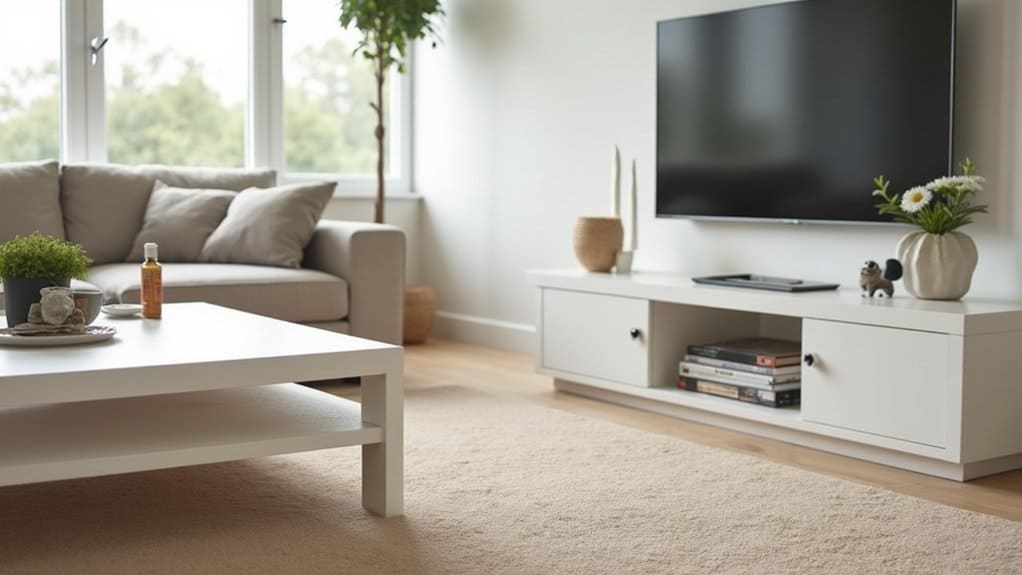
Since you’ve got toy storage sorted, let’s plunge into keeping your playroom-in-the-living-room safe for those tiny tornadoes! Man, I’ve tripped over enough toys to know safety’s no joke!
Start with Corner Guards. Grab soft foam guards—3M brand sticks well—and cover sharp table edges. Measure 2-inch strips for full coverage. Next, Secure Furniture. Use anti-tip straps (like Safety 1st, under $10) to anchor shelves to walls with 1-inch screws. I nearly lost a bookcase once—yikes! Finally, Hide Cords. Bundle wires with 12-inch cable ties. Trust me, no kid should tangle with those! Safety first, folks!
4. Choose Comfortable Seating

Hey, now that we’ve got safety locked down with those corner guards and strapped furniture, let’s switch gears to making this playroom cozy! Seating’s key, y’all! I’m pumped to help you pick the best spots for little bums.
Start with a soft, kid-sized bean bag—get one about 30 inches wide from Target for under $40. They’re squishy and safe! Or, grab a small foam chair (around 24×18 inches) with a washable cover. I once spilled juice on mine—disaster! Place two or three near a low table for comfy playtime. Trust me, your kiddos will love it!
5. Create Playful Decorations
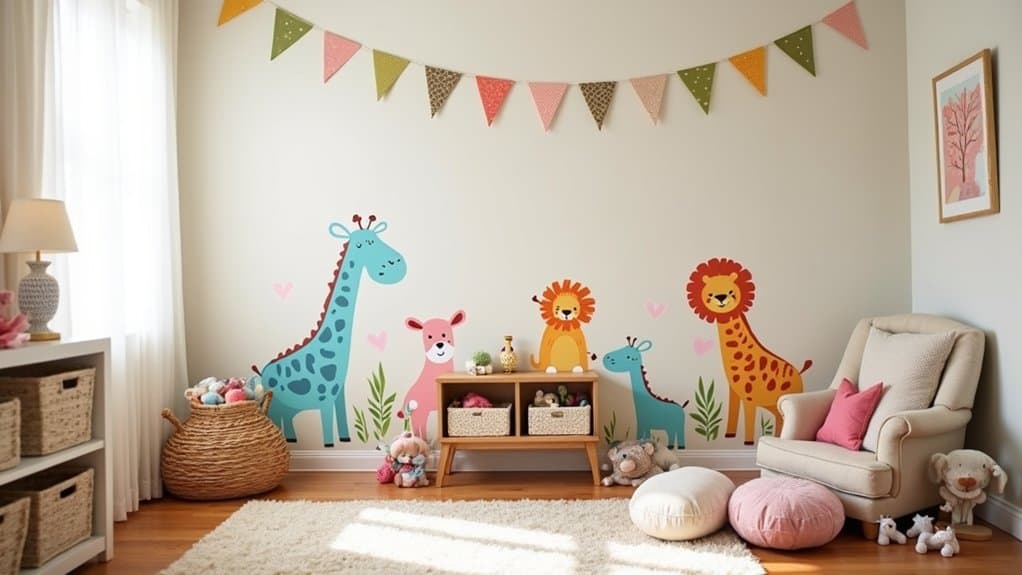
Alright, let’s plunge into transforming your living room playroom with some super fun decorations! I’m so excited to share this with you—let’s make it pop!
Start with wall decals; they’re easy stickers for instant flair. Grab a pack of 24-inch jungle animal decals from any craft store, and stick ‘em up at kid-eye level, about 3 feet high.
Next, craft a DIY bunting. Cut 8×10-inch fabric triangles—old shirts work if you mess up like I did! String ‘em on a 6-foot rope with hot glue. Hang it high for a festive vibe. Wow, it’s adorable!
6. Set Up Activity Zones

While transforming your living room into a playroom, setting up activity zones is the key to keeping things fun and organized! I’ve tripped over toys myself, so trust me, this works! Let’s make this space awesome together!
First, define your zones. Grab a 5×5 ft. rug for a cozy reading nook with a beanbag chair—under $20 at Walmart! Then, set a 4×6 ft. craft area with a small table (IKEA’s LACK, $10) for drawing.
Next, create a pretend-play corner. Use a 3×3 ft. space with a toy kitchen. Watch out—don’t stub your toe like I did! Sweet setup, right?
7. Organize Interactive Games
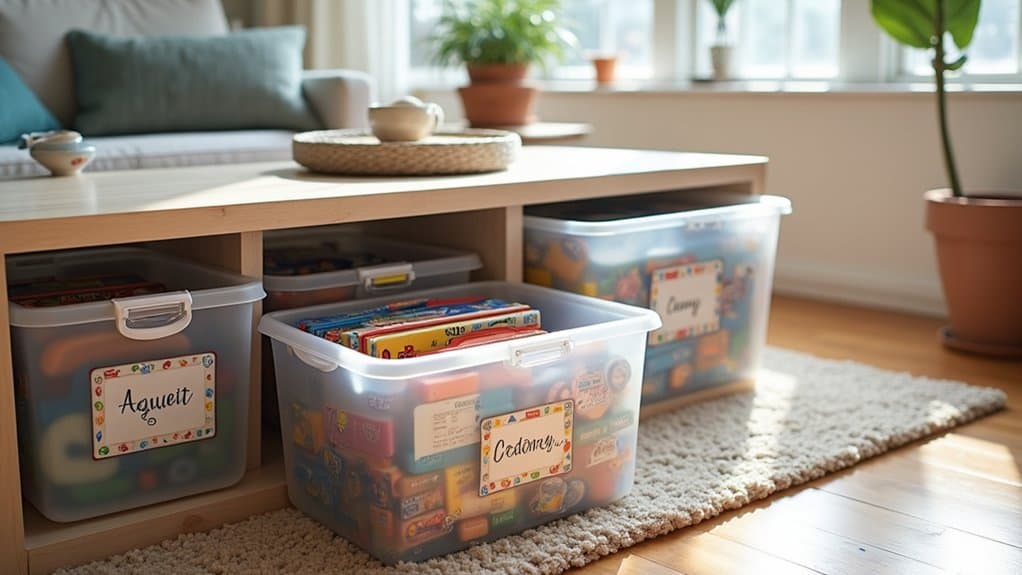
Three key steps can make organizing interactive games in your living room playroom a total breeze! I’ve stumbled through this myself, so trust me, you’ve got this! Let’s jump in with excitement!
First, pick games for ages 3-8, like “Simon Says” or board games such as Candy Land. Store them in a 12”x18” clear bin under a coffee table—keeps ‘em handy!
Second, label bins with fun stickers. I once mixed up puzzle pieces—disaster!
Lastly, rotate games weekly to keep kids thrilled. Set a 10-game max to avoid chaos. You’ll love the organized fun!
8. Install Soft Play Mats
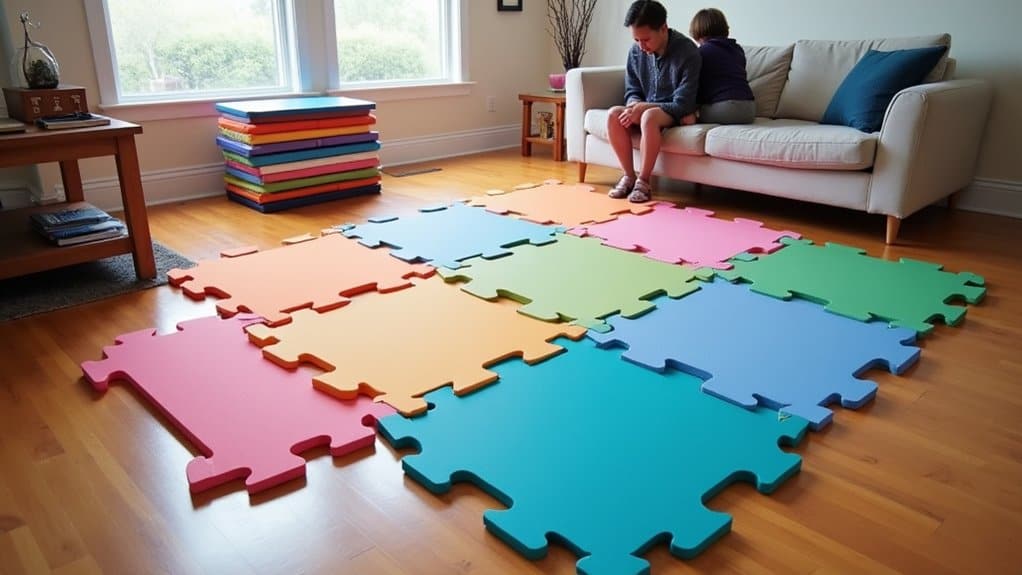
Hey there, let’s transform that living room playroom with some cozy soft play mats—I’m so pumped to guide you through this! Man, I’ve tripped on hard floors before, so trust me, this is a game-changer!
First, measure your space. Grab a tape measure and check the play area—most mats come in 2×2 foot squares, so calculate how many you’ll need for, say, a 6×8 foot spot.
Next, pick safe mats! Go for non-toxic, EVA foam ones with interlocking edges. Lay them down, puzzle-style, ensuring no gaps. Done! Your kiddos now have a cushy, safe spot—yay!
9. Add Child-Friendly Lighting
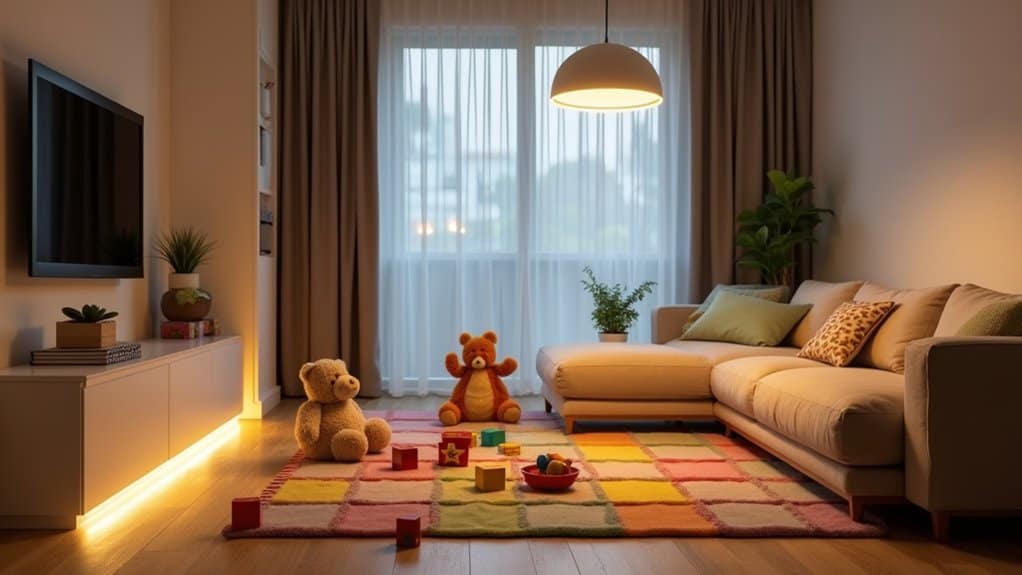
Let’s brighten up this living room playroom now that those soft play mats are down! I’ve tripped over toys in dim light before, and trust me, it’s no fun! So, let’s keep things safe and cheery.
Start with LED nightlights—plug in two, about 3 feet apart, along baseboards. They’re low-wattage (under 5 watts) and kid-safe with soft glows. Next, hang a colorful pendant light (18-inch diameter max) over the play area—use a low-heat bulb (LED, 40 watts). Secure it 7 feet high to avoid head bumps. Wow, it’s looking brighter already! What a transformation!
10. Personalize Wall Art
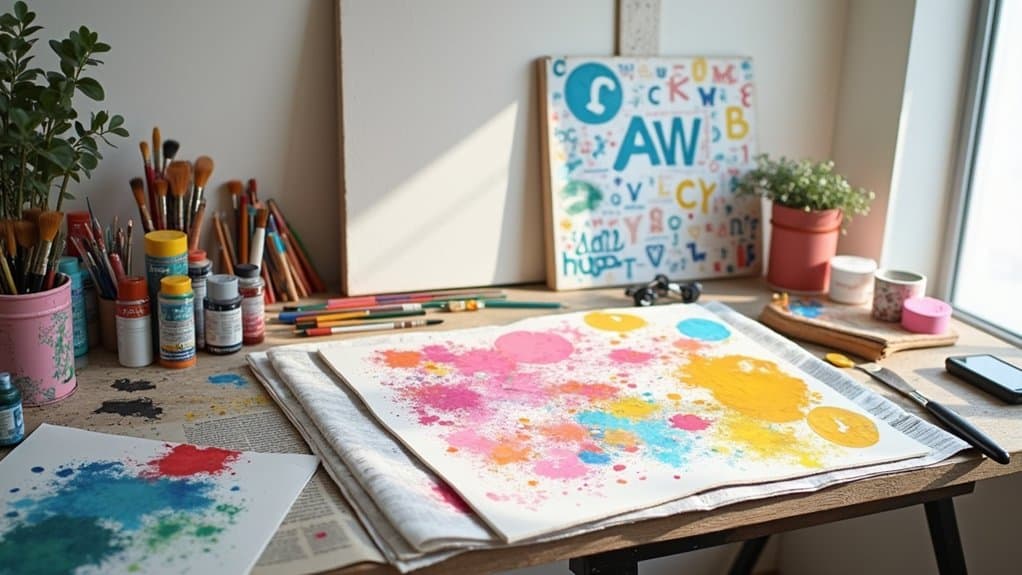
As we brighten up this living room playroom, it’s time to add a splash of personality with some custom wall art! I’m thrilled to help you make this space scream “fun” for your kids. Let’s get crafty!
First, grab some basics. You’ll need:
- 2 canvas panels (16×20 inches)
- Acrylic paint (bright colors!)
- Stencils or stickers for names
Pick a wall spot—about 4 feet high for kid-eye level. Paint a base layer; I once splattered paint everywhere, oops! Add your child’s name with stencils. Hang securely with 3M strips. Voila, it’s uniquely theirs!

